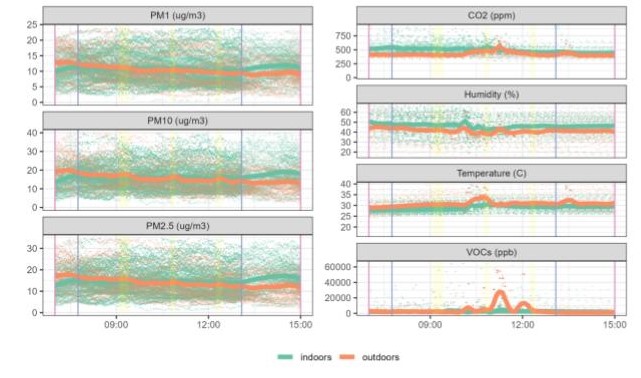Our team along with two innovation companies (LELANTUS and PHOEBE) and the Department of Electrical Engineering of CUT published the results of a school population representative, cross sectional study (STEPS) on the indoor air quality (IAQ) status in primary schools of Cyprus, when the May–July 2021 COVID-19 school protocol measures were in place.
Using a suite of exposomic tools, the STEPS monitored and analyzed IAQ parameters using low-cost sensors and questionnaire-based information on each participating school/classroom during the Cyprus-wide 2021 COVID-19 school protocol implementation.
The objectives of the STEPS study were:
to describe the magnitude and variance of a suite of environmental parameters [air temperature, Relative Humidity (RH), Particulate Matter (PM), and chemicals [Carbon Dioxide (CO2); Volatile Organic Compounds (VOCs)] in classrooms of public primary schools located in densely and intermediately populated areas of Cyprus
to compare the magnitude of the environmental stressors indoors versus outdoors
to compare the variability of the IAQ metrics against recommended cutoff values by international authoritative organizations
It was shown that:
Most of the school time (85%), the indoor air temperature was higher than the upper limit of 27 °C recommended by the European standard on the energy performance of buildings, while 33% of the 24-hour PM2.5 measurements exceeded the WHO-recommended guideline value
Natural ventilation in classrooms with windows and doors being systematically open in practice showed that the health protocol in place was respected and helped in keeping CO2 levels within acceptable levels for the majority of school time
The way forward:
The deployment of IAQ monitoring schemes within a broader methodological framework of the indoor exposome in schools would pave the way for quantifying the cost of the attributable burden of disease, and thus monetizing possible IAQ and health interventions in a changing climate.
More environmental and health data is needed to support the new WHO Global Air Quality guidelines that were recently put forward (September 2021). Such efforts would further strengthen health arguments for climate action in school systems, as well as in other indoor settings.
Read the full article here:
https://www.cell.com



